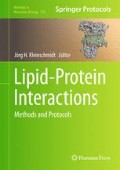Abstract
A large number of proteins are capable of inserting themselves into lipids, and interacting with membranes, such as transmembrane proteins and apolipoproteins. Protein–lipid interactions have been identified as one of the keys in understanding biological processes, while the structure of proteins at the lipid-binding stage can provide evidence to help identify their roles and critical functions. However, structure determination of proteins at the lipid-binding stage is rather difficult, because conformational and compositional heterogeneities of the protein–lipid complexes are major barriers to unravel their structures using traditional methods, such as X-ray crystallography. Electron microscopy (EM) is an alternative approach to determine protein structure and has demonstrated a capability in visualizing lipid–protein interactions directly. Among various EM techniques, negative-staining (NS) is an easy, rapid, qualitative approach that is a well-established technique, frequently used in research laboratories. Conventional NS protocols, unfortunately, often generate artifacts with lipid-related proteins, such as the rouleau formation of lipoproteins. To overcome this artifact formation, Ren and his colleagues recently developed an optimized NS protocol that was validated by comparing images of lipoproteins from cryo-electron microscopy (cryo-EM). The optimized NS protocol could produce “near native-state” particle images and high contrast images of the protein in its lipid-binding state that is favorable for three-dimensional (3D) reconstruction by single-particle analysis and individual-particle electron tomography (IPET), suggesting this optimized protocol can be used widely to examine the structure of proteins at lipid-binding stage.
Access this chapter
Tax calculation will be finalised at checkout
Purchases are for personal use only
References
Reichow SL, Gonen T (2009) Lipid–protein interactions probed by electron crystallography. Curr Opin Struct Biol 19:560–565
Gennis RB, Jonas A (1977) Protein-lipid interactions. Annu Rev Biophys Bioeng 6:195–238
Gonen T, Cheng YF, Sliz P, Hiroaki Y, Fujiyoshi Y, Harrison SC, Walz T (2005) Lipid–protein interactions in double-layered two-dimensional AQPO crystals. Nature 438:633–638
Ren G, Rudenko G, Ludtke SJ, Deisenhofer J, Chiu W, Pownall HJ (2010) Model of human low-density lipoprotein and bound receptor based on CryoEM. Proc Natl Acad Sci U S A 107:1059–1064
Kumar V, Butcher SJ, Oorni K, Engelhardt P, Heikkonen J, Kaski K, Ala-Korpela M, Kovanen PT (2011) Three-dimensional cryoEM Reconstruction of native LDL particles to 16 Å resolution at physiological body temperature. PloS One 6:e18841
Ludtke SJ, Baldwin PR, Chiu W (1999) EMAN: semiautomated software for high-resolution single-particle reconstructions. J Struct Biol 128:82–97
Frank J, Radermacher M, Penczek P, Zhu J, Li Y, Ladjadj M, Leith A (1996) SPIDER and WEB: processing and visualization of images in 3D electron microscopy and related fields. J Struct Biol 116:190–199
Zhang L, Song J, Newhouse Y, Zhang S, Weisgraber KH, Ren G (2010) An optimized negative-staining protocol of electron microscopy for apoE4∙POPC lipoprotein. J Lipid Res 51:1228–1236
Orlova EV, Sherman MB, Chiu W, Mowri H, Smith LC, Gotto AM (1999) Three-dimensional structure of low density lipoproteins by electron cryomicroscopy. Proc Natl Acad Sci U S A 96:8420–8425
Zhang L, Song J, Cavigiolio G, Ishida BY, Zhang S, Kane JP, Weisgraber KH, Oda MN, Rye K-A, Pownall HJ, Ren G (2011) Morphology and structure of lipoproteins revealed by an optimized negative-staining protocol of electron microscopy. J Lipid Res 52:175–184
Ohi M, Li Y, Cheng Y, Walz T (2004) Negative- staining and image classification—powerful tools in modern electron microscopy. Biol Proced Online 6:23–34
Oliver RM (1973) Negative stain electron microscopy of protein macromolecules. Methods Enzymol 27:616–672
Woeste S, Demchick P (1991) New version of the negative stain. Appl Environ Microbiol 57:1858–1859
Bradley DE (1962) A study of the negative-staining process. J Gen Microbiol 29:503–516
Cunningham WP, Staehelin LA, Rubin RW, Wilkins R, Bonneville M (1974) Effects of phosphotungstate negative-staining on the morphology of the isolated Golgi apparatus. J Cell Biol 62:491–504
Egelman EH, Amos LA (2009) Electron microscopy of helical filaments: rediscovering buried treasures in negative stain. Bioessays 31:909–911
Melchior V, Hollingshead CJ, Cahoon ME (1980) Stacking in lipid vesicle-tubulin mixtures is an artifact of negative-staining. J Cell Biol 86:881–884
Innerarity TL, Pitas RE, Mahley RW (1979) Binding of arginine-rich (E) apoprotein after recombination with phospholipid vesicles to the low density lipoprotein receptors of fibroblasts. J Biol Chem 254:4186–4190
Peng D, Song C, Reardon CA, Liao S, Getz GS (2003) Lipoproteins produced by ApoE−/− astrocytes infected with adenovirus expressing human ApoE. J Neurochem 86:1391–1402
Schneeweis LA, Koppaka V, Lund-Katz S, Phillips MC, Axelsen PH (2005) Structural analysis of lipoprotein E particles. Biochemistry 44:12525–12534
Ren G, Zhang S, Cavigiolio G, Lei D, Krauss RM, Oda M, Weisgraber KH, Rye KA, Pownall HJ, Qiu X (2010) Cholesteryl ester transfer protein penetrates lipoproteins for cholesteryl ester transfer. Biophys J 98:36a
Zhang L, Yan F, Zhang S, Lei D, Charles MA, Cavigiolio G, Oda M, Krauss RM, Weisgraber KH, Rye K-A, Pownall HJ, Qiu X, Ren G (2012) Structural basis of transfer between lipoproteins by cholesteryl ester transfer protein. Nat Chem Biol 8:342–349.
Zhang L, Ren G (2010) Determining the dynamic protein structure by individual-particle electron tomography: an individual antibody structure at a nanometer resolution. Biophys J 98:441a–441a
Zhang L, Kaspar A, Woodnutt G, Ren G (2010) Monitoring the structural changes of conjugated antibodies by high-resolution electron microscopy and individual-particle electron tomography. Biophys J 98:440a–441a
Zhang L, Ren G (2012) IPET and FETR: Experimental Approach for Studying Molecular Structure Dynamics by Cryo-Electron Tomography of a Single-Molecule Structure. PLoS One 7:e30249.
Author information
Authors and Affiliations
Corresponding author
Editor information
Editors and Affiliations
Rights and permissions
Copyright information
© 2013 Springer Science+Business Media New York
About this protocol
Cite this protocol
Garewal, M., Zhang, L., Ren, G. (2013). Optimized Negative-Staining Protocol for Examining Lipid-Protein Interactions by Electron Microscopy. In: Kleinschmidt, J. (eds) Lipid-Protein Interactions. Methods in Molecular Biology, vol 974. Humana Press, Totowa, NJ. https://doi.org/10.1007/978-1-62703-275-9_6
Download citation
DOI: https://doi.org/10.1007/978-1-62703-275-9_6
Published:
Publisher Name: Humana Press, Totowa, NJ
Print ISBN: 978-1-62703-274-2
Online ISBN: 978-1-62703-275-9
eBook Packages: Springer Protocols

